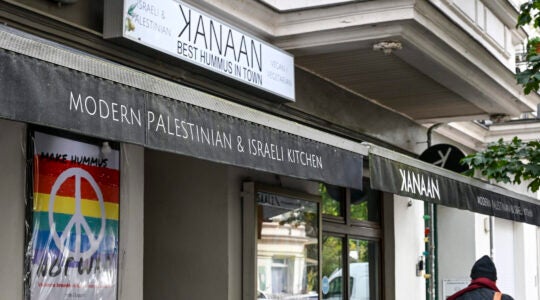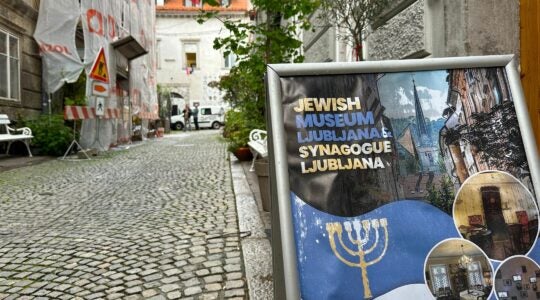ROME (JTA) – Settimio Limentani no longer feels at home in the Jewish ghetto here, where he grew up, where he knew everybody and everybody had a nickname, and where his family has lived and worked for hundreds of years.The family clothing store on the main plaza was first leased in 1846 by the ruling papal authorities.Now Limentani may have to give up the business because real estate in Rome’s ghetto has skyrocketed, and so have the rents. While rents have about doubled in other parts of Rome in the past five years, prices in the ghetto have tripled, and apartments with light and a view are now going for as much as $1,000 per square foot. That has taken a toll on the Jewish presence, Limentani says. “The ghetto as a real place no longer exists,” said Limentani, known as “Titti” in the ghetto. “It’s become
a tourist attraction, with a few old Jews sitting around like extras on
a film set. It’s become fashionable, people are paying fortunes for
apartments, the Jews have moved out.”In 1945, about 6,000 of Rome’s 11,000 Jews
still lived in the ghetto, an area of about 300 yards by 250 yards. Today only about 700 Jews live there, according to
community statistics. Many buildings have been renovated in the past few years. Squalid,
low-rent dwellings have been transformed into expensive jewel boxes,
and foreigners and non-Jewish Romans have moved in because of the medieval
charm of the cobblestoned streets and the fashionable, central location. Most of the renovation work has been paid for by the owners of individual buildings. The city has cleaned up the main piazza, turned it into a pedestrian area, and installed some benches and potted plants.While Jewish residents have left, the community’s main institutions remain firmly rooted in the ghetto. The Tempio Maggiore, Rome’s biggest synagogue, is there, as are the community’s administrative and rabbinical offices.
Limentani’s store selling shirts, nightwear and underwear is one of the
few surviving discount outlets, which were the hallmark of the ghetto until just a few years ago. Romans would
head to “Il Ghetto,” as it’s still known, to shop for cloth, clothing
and household goods at reduced prices.Standing outside his shop, Limentani looks bewildered by the new crop
of kosher fast-food spots with neon signs, and boutiques selling Jewish
ornaments and religious objects, as platoons of tourists stroll through.Limentani says that if Jewish shopkeepers no longer have businesses in the ghetto, the
community basically has ceased to exist.”It’s no good cleaning up the streets,
repainting the buildings, making a pedestrian area with potted plants
and announcing we have renovated the ghetto if the Jews have left,” he said. The voluntary exodus of Jews from the ghetto stretches back more than a century. Under the rule of the popes, Rome’s Jews were obliged to live in the ghetto beginning in 1555, and were even locked in at night. Only in 1870, when Italian troops conquered Rome, were they allowed to live elsewhere in the city. Jews who could afford to leave the dark, unsanitary dwellings moved to other parts of the city, particularly the Trastevere quarter across the Tiber River. Many residents also left at the turn of the 20th century, when some of the medieval buildings were demolished to make space for a new synagogue, a symbol of the emancipation of Rome’s Jews.The next major exodus came in the 1960s. With the city’s economic boom, many ghetto residents dreamed of modern housing. They sold their old homes and moved to new residential neighborhoods on the city’s outskirts.”But the Jews who moved out still saw the ghetto as their ancestral neighborhood,” said Angelo Sermoneta, known as “Baffone,” who runs a social club in the ghetto. “The old ladies used to sit out in the streets on chairs brought down from their apartments. So when the family moved away, they would get a relative to drive them down to the ghetto, bringing a chair from miles away, and sit out with their old friends.”The 80-year-old proprietor of a cafe and tobacco shop on the ghetto’s main street, Via Del Portico D’Ottavia, remembers those days. “There was nothing charming or fashionable then,” said the man, who asked that his name not be used. “The crowding was terrible, many apartments had only makeshift toilets, the plumbing was medieval. Lots of people sold out and moved. They couldn’t wait to have modern bathrooms and kitchens, windows with light and space.”In the past 30 years the city’s old working-class quarters, like Trastevere and Campo de Fiori, have become fashionable and expensive. The ghetto was the last quarter to undergo gentrification.Rome’s Jewish community recently moved two of the three Jewish schools from Trastevere to a large building on the ghetto’s main street.”This is to maintain the Jewish identity of the quarter,” community spokesman Riccardo Pacifici said. “Now there are young people here. After school they hang out, where before there were only old people.”But the truth is that economic changes are inevitable,” he said. “You can’t have it both ways. You can’t have a ghetto that is all cleaned up and renovated right in the center of Rome, and object that prices have rocketed.”Leone Passerman, president of the Jewish community, has come under fire for not defending the old residents and shopkeepers.
“A lot of those who are complaining today sold out a few years ago when
prices started rising,” Passerman said. “In any case, we as a community
do what we can, but we cannot interfere in the real estate market. We
have brought the schools into the ghetto. Beyond that there is little
we can do.”
Next door to Limentani’s shop, a small store just opened. Over the door a sign identifies it as the “Jewish Info Point.”
Talking about the Roman government and the city’s Jewish community, Limentani says, “They are turning the ghetto into a museum.”
JTA has documented Jewish history in real-time for over a century. Keep our journalism strong by joining us in supporting independent, award-winning reporting.





